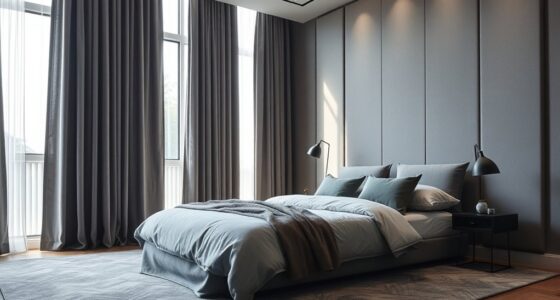To add depth with accent walls and textures while maintaining a restful sleep, choose soft, neutral colors and subtle textures that create visual interest without overwhelming your space. Use gentle lighting to highlight these features without causing glare or shadows. Avoid overly bold textures or dark shades in small rooms, as they can feel crowded. Balancing these elements helps you create a cozy, inviting atmosphere. Explore more ways to enhance your room while keeping it tranquil.
Key Takeaways
- Use soft, warm lighting to subtly highlight textured accent walls without creating glare or shadows that disturb sleep.
- Opt for lighter hues and subtle textures on accent walls to add depth while maintaining a calming, spacious feel.
- Incorporate gentle, indirect lighting to emphasize textures softly, enhancing visual interest without overstimulation.
- Avoid bold, dark textures in bedrooms; instead, select muted tones and delicate patterns for a restful atmosphere.
- Balance textured accent walls with minimalistic decor and subdued lighting to create a cozy yet tranquil sleep environment.

Adding an accent wall or textured surface can instantly transform a room’s look and feel. It’s a simple way to introduce personality and depth without overwhelming your space or disrupting the calming atmosphere you want for sleep. When considering an accent wall, one of the most impactful factors is lighting options. The way you light it can either highlight the texture or make it fade into the background, depending on the effect you desire. Soft, warm lighting often enhances the subtle details of textured surfaces, creating a cozy and inviting vibe that’s perfect for a bedroom. Conversely, direct or harsh lighting can emphasize the wall’s features, which might be more suitable for living areas but could be too stimulating for a sleep space. You want to select lighting that complements the textures without creating glare or shadows that might disturb your rest. Additionally, understanding the impact of lighting on textures can help you choose the most suitable illumination.
Another key aspect to think about is how an accent wall influences your room size perception. Darker colors and heavily textured surfaces tend to make a space feel smaller or more intimate, which can be beneficial if you want to create a cozy retreat. However, in smaller rooms, using large patterns or bold textures might make the space feel crowded or overwhelming. In contrast, lighter shades with subtle textures can open up the room, making it feel larger and more airy. Strategically choosing the right colors and textures helps balance visual interest with spatial comfort, ensuring your bedroom remains a restful haven. If your room feels too tight, opt for a lighter hue on the accent wall and keep textures understated to avoid claustrophobia. If you have a larger room and want to add drama, darker or more complex textures can add depth without shrinking the space.
Ultimately, the goal is to enhance your room’s aesthetic while maintaining a peaceful environment conducive to sleep. Carefully selecting lighting options that highlight textures softly, and choosing colors and textures that either expand or cozy up your space, will help you achieve this. Remember, the best accent walls and textures are those that reflect your style but also support the restful atmosphere you need. With thoughtful choices, you can enjoy a visually interesting room that promotes relaxation and restful sleep, all without sacrificing comfort or tranquility.
Frequently Asked Questions
Can Textured Walls Affect Sleep Quality?
Textured walls can affect your sleep quality if they trap dust or mold, which may cause allergies or respiratory issues. To minimize disruption, use soundproofing techniques to block noise and guarantee proper wall texture maintenance, keeping surfaces clean and free from allergens. Choose subtle textures that don’t create visual clutter or trap dust easily, helping you rest better without sacrificing style or depth in your room.
What Colors Are Best for Relaxing Accent Walls?
Opt for soothing color palettes, calming paint options, and gentle hues to create the best relaxing accent walls. Soft blues, muted greens, and warm neutrals promote tranquility, reduce stress, and foster restful sleep. You should avoid overly bright or bold colors that can stimulate your mind and disrupt your rest. Choose colors that evoke serenity, encourage relaxation, and transform your space into a peaceful retreat.
How Do I Choose the Right Texture for My Bedroom?
You should choose textures that create a calming atmosphere, like soft fabric or smooth plaster. Consider material options such as velvet, linen, or textured wallpaper with subtle patterns. Avoid overly busy or rough textures that can be visually stimulating. Opt for simple, soothing patterns that add depth without overwhelming your space. By selecting the right material and pattern, you guarantee your bedroom remains a peaceful, sleep-friendly retreat.
Are There Low-Maintenance Textures Suitable for Bedrooms?
Think of your bedroom as a sanctuary; you want it to be both beautiful and effortless. Low-maintenance textures like washable paint or textured wallpaper offer durable wall surfaces that resist wear and tear. These finishes are easy to clean and require minimal upkeep, so you can enjoy your space without worry. Choosing such textures guarantees your bedroom stays inviting and serene, fitting your lifestyle perfectly.
Can Lighting Change the Perception of Textured Walls?
Yes, lighting can definitely change the perception of textured walls. You can use different lighting ambiance to highlight or soften wall textures, creating various wall color effects. Warm lighting enhances cozy, inviting textures, while cooler lighting emphasizes depth and details. By adjusting your lighting, you can transform your room’s mood, making textured walls feel more subtle or striking, without disrupting your sleep environment.
Conclusion
By choosing the right accent walls and textures, you’re painting a subtle masterpiece in your space—an invitation for your room to breathe and grow. Think of it as planting a single vibrant flower amid a quiet garden, adding depth without disturbing the peaceful harmony. When you balance boldness with serenity, your bedroom becomes a sanctuary—a sanctuary where your dreams can blossom as freely as a morning sun breaking through gentle clouds.









